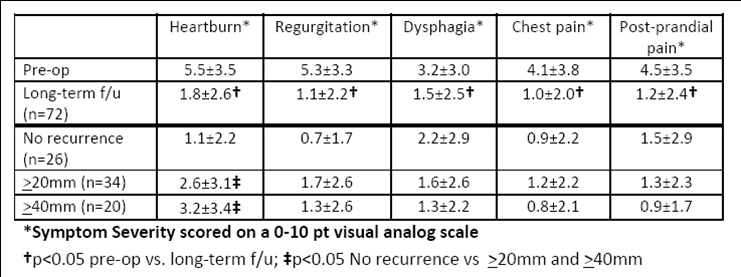Laparoscopic Paraesophageal Hernia Repair: Defining Long-Term Clinical and Anatomic Outcomes
Brant K. Oelschlager1, Rebecca P. Petersen*1, L.Michael Brunt2, Nathaniel J. Soper3, Brett C. Sheppard4, Lee Mitsumori5, Charles Rohrmann5, Lee L. Swanstrom6, Carlos a. Pellegrini1
1Surgery, University of Washington, Seattle, WA; 2Surgery, Washington University, St. Louis, MO; 3Surgery, Northwestern University, Chicago, IL; 4Surgery, Oregon Health & Science University, Portland, OR; 5Radiology, University of Washington, Seattle, WA; 6Surgery, The Oregon Clinic, Portland, OR
Objective: We recently determined in a multi-institutional, prospective, randomized study of laparoscopic paraesophageal hernia repair (LPEHR) that the 5-year anatomic recurrence rate as determined by upper GI barium x-rays (UGI) was > 50%. This study analyzes the impact of hernia recurrence after LPEHR on clinical symptoms at 5-year follow-up. Methods: From 2002 to 2005 we enrolled 108 patients with PEH who agreed to participate in the study and undergo LPEHR and Nissen fundoplication with or without the use of biologic mesh. UGI and symptom questionnaire (frequency and severity of 9 commonly associated foregut symptoms) were performed at baseline, 6 months post-operatively, and approximately 5 years after the operation, during 2009. Results: Of 108 patients, 72 could be contacted and surveyed and 60 of them had an UGI. The median follow-up was 58 months (42-78) and the average age at follow-up was 68 ± 10 years. Overall radiographic recurrence (≥20mm) was 14% at 6 months and 57% at 5 years, and the average size of the recurrence was 40 ± 10mm. All symptoms continued to be significantly better than before repair at 5 years, and with the exception of heartburn appeared to be unaffected by the presence or size of the recurrence (Table I). Two patients had a re-operation during this follow-up for symptoms related to their recurrent hernia. Ten patients had died, but none as a complication of their LPEHR.Conclusion: Despite an overall high rate of radiologic recurrence following LPEHR, patient satisfaction remains high, radiologic recurrences are well tolerated, and the need for reoperation is very low.
Back to 2011 Program



